Learn to Fish – Guide
This guide is designed to show you how easy it can be to fish in Ontario. Understanding these basics will give you more confidence and help you enjoy your time on the water.
Fishing is a fun and relaxing way to spend time outdoors, but for some people just getting started into the sport, it can be intimidating. There’s a lot to learn when it comes to fishing, like which fishing rod and tackle to choose, how to follow the fishing regulations, and how to identify fish species. These are only a few challenges beginner anglers face when taking up fishing for the first time.
This guide is suitable for people of all ages and is designed for online reading or printing. If you would like a more interactive experience with videos and quizzes, check out our Learn to Fish Online program.
Fishing rods, reels and line
Choosing a rod and reel can seem overwhelming when faced with the broad selection at the tackle shops or big box stores. Here are the different types for you to consider, but we recommend sticking to the basic set-ups to get started.
Types of rods and reels
Spinning
We recommend this setup for beginners, since they are relatively inexpensive and simple to use. These open-faced reels are easy to take apart and untangle line. For children, start with a shorter rod, about 4-5 ft (approximately 1.5m).
Spincasting
These fishing rods have a button release for casting, making them easy to use for children. However, the closed-faced rods make untangling line more difficult and they don’t cast as far or as accurately.
Bait-casting
Often used for heavier lures and lines, bait-casting reels provide more power and accuracy when casting. These set-ups are prone to tangle and we recommend them for more advanced anglers.
Fly
This gear is completely different from other fishing equipment and is most commonly used when fishing in rivers for salmon or trout. The lures (called flies) are almost weightless, while the heavier line allows for casting. This style of fishing is fun and rewarding but also needs a lot of practice.
Types of line
Monofilament
Strong, stretchy, and durable, this line is the most common type of fishing line. A great all-purpose line, this is recommended for beginner anglers.
Fluorocarbon
Used more in bait-casting reels, fluorocarbon is stronger and denser than monofilament and appears almost completely transparent underwater. Fluorocarbon is a bit more expensive and is often used as leader material near your lure.
Braided
As the name would suggest, this line is braided. This makes it very strong and thin compared to the other lines, but it can be more visible in the water. Braided line is generally the most expensive.
How to spool line on a spinning reel
Step 1: Feed your line through line guides, starting at the top of your rod.

Step 2: Flip your bail to the open position and create a knot around reel.

Step 3: Flip your bail back over and start reeling in the line, holding the line to keep tension.
Step 4: Fill the reel and stop.
Step 5: Cut the line. Now you’re ready to attach your tackle.
Tackle and other gear
Now that you have your fishing rod assembled, you’ll need to attach your tackle. Here is a run through of some bait, lures, and other gear to complete your fishing set-up.
Basic tackle
Hooks
This is what catches the fish! Hooks usually have barbs, which can be bent down to help release fish faster. Note: You aren’t allowed to use barbed hooks in some waterbodies. You can find waterbody specific rules in the Recreational Fishing Regulations Summary and Fish ON-Line.
Floats (or bobbers)
These have two functions: they suspend your bait in the water at a specific depth and also help show you when you have a bite.
Weights (or sinkers)
Sinkers help weigh your bait down, getting closer to the fish! They are traditionally made of lead, but there are also non-toxic options made of steel or tungsten.

Types of bait
Natural bait
- Common types include earthworms, minnows, crayfish, and mealworms.
- Keep in mind, you cannot release live bait or dump the contents of a bait bucket into the water or within 30 metres of any waterbody.
- Note: You aren’t allowed to use live bait in some waterbodies. You can find waterbody specific rules in the Recreational Fishing Regulations Summary and Fish ON-Line

Soft-plastic bait
These soft-bodied baits are meant to imitate natural bait. Soft-plastic worms and minnows also come with flavour enhancers to imitate the smell and taste of the real thing.
Types of lures
Choosing a lure can be confusing; it sometimes seems like there are endless options! Here are a few basic lure types you may encounter:
Spoons and spinners
These wobbling and spinning bait mimic injured baitfish. Their weight allows for more accurate casting and sink deeper in the water. These can be used for casting or trolling.
Note: since spinners and spoons “spin,” use a snap-swivel (below) to avoid twisted line.

Plugs
These hard-bodied baits come in various types: crankbaits (rounded deep divers), jerkbaits (slender shallow divers), and poppers (surface lure). Plugs mimic injured baitfish, frogs, or anything else that can be eaten.
Jigs
Essentially a single hook with a weighted eye, jigs rely on the angler to create the motion. When used properly, they create a jerky vertical motion. Can be used alone or with natural bait.

Other gear for your tackle box
Snap swivels
These are often tied to the end of your line. They keep your line from twisting and make switching up your bait or lure easier.
Needle-nosed pliers
These are helpful for squeezing sinkers onto your line and bending down barbs. They are also great for releasing deeply hooked fish or unhooking a fish with teeth.
Net
Small fish are okay to be lifted straight out of the water, but larger fish could break your line. Put your net in the water, guide the fish overtop, and either raise your net or take out the hook while the fish is still in the water.
Scissors or nail clippers
Great for cutting off the tag ends of knotted line.
Measuring tape and scale
If you plan to keep your catch, some fish have size restrictions and require you to measure their length. It’s also fun to find out the size of your catch!
First Aid Kit
Always a good idea to keep handy. Hooks and fish spines are sharp!
Gloves
Great for larger fish with teeth or for protecting yourself from sharp spines.
Knots and casting
Once you’ve picked out your tackle, you’ll need to know how to attach it to your line and how to get it into the water.
Tying a Palomar knot
There are lots of knots out there, but we recommend the Palomar knot for its strength and ease of use.
Step 1: Fold your line in half and feed through the eye of your hook, snap-swivel, or lure.

Step 2: Tie an overhand knot with the loop, but don’t pull tight.

Step 3: Feed the hook through the loop.

Step 4: Wet your line, pull tight, and cut the tag end.

Casting
Casting your line is easy, once you get the hang of it. To practice, try in your backyard or elsewhere on dry-land with the hook removed from a lure. Always make sure to look around you for trees, people, or obstacles. Here are the steps for casting a spinning rod.
Step 1: Hold the line against the rod with your index finger.
Step 2: Using your other hand, flip the bail.
Step 3: Position rod over your shoulder at the 1 o’clock position.

Step 4: Throw rod forward, releasing line around the 11 o’clock position.

Step 5: After you cast, flip your bail back over to secure line.
Rules and regulations
Ontario has fishing rules and regulations in place to protect our natural resources. Here are the basics for fishing legally within the province.
Read the Ontario Recreational Fishing Regulations Summary
In the Summary’s introduction, you’ll find general rules and regulations that apply to all anglers, along with a map that divides Ontario into 20 Fisheries Management Zones. When you know where you plan to fish, find your zone and read through the section. The Summary will list species limits, seasons, and any additional rules for specific waterbodies. It is your responsibility to make sure you are fishing according to the regulations. For the rules that apply to one particular waterbody, check out Fish ON-Line. Search and click on the waterbody you plan to fish to see the rules.
Get a fishing licence
There are two kinds of fishing licences: Sport and Conservation. A Sport fishing licence allows anglers to keep more fish, and a Conservation fishing licence allows for a reduced catch limit. If you plan to practice catch and release fishing, a Conservation licence is recommended.
If you’re a Canadian resident under the age of 18 or 65 and older, you don’t need to buy a fishing licence. Some other Canadian residents automatically have a deemed licence, such as people with disabilities and veterans and active Canadian Armed Forces members. For these groups, government issued ID is required. Review the Summary for specifics.
Before you purchase a fishing licence, you will need an Outdoors Card. This card lasts for three years and accompanies your fishing licence.
You can purchase your fishing licence and Outdoors Card online or at a participating ServiceOntario or licence issuer.
Identifying, catching and handling fish species
To fish according to the regulations, you need to know how to identify your catch. Here is some information to help you identify and catch common Ontario fish species.
Sunfish (pumpkinseed, bluegill, rock bass, and crappie)
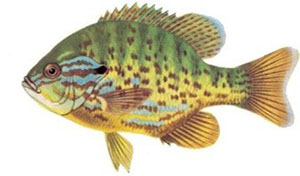
Species-Pumpkinseed
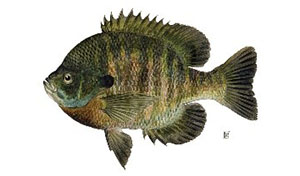
Species-Bluegill
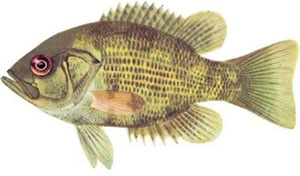
Species-Rock Bass
Species-Crappie
These colourful little scrappers are abundant in many Ontario waters. They usually weigh 0.11 kg to 0.23 kg (four to eight ounces) but can grow as big as 0.45 kg to 0.9 kg (a pound or two). They are tall but thin, almost in the shape of a hand.
Aggressive feeders, sunfish take bait readily, fight well on light tackle, and are great to eat. They are found in the shallows of warmer lakes, ponds and slow-moving streams. Try fishing near rocks, weed beds, floating docks or anything else that would give them a place to hide.
Rock bass, as the name implies, prefer rocky areas. Fish with a bobber and worms, adjusting the depth of the bait until you find where they are. You can also try small plugs, spinners or jigs.
Black crappie in particular seem to like small minnows. However, their mouth tissues are thin, and hooks can pull out unless handled carefully.
Smallmouth and largemouth bass
As the names imply, the easiest way to tell these two fighters apart is the size of the mouth. In largemouth bass, the jaw hinge extends past its large eye. In smallmouth bass, it doesn't go past the centre of the eye.

Species-Largemouth Bass
While the two species sometimes overlap territories, Largemouth bass are more often found in warmwater weed beds. Largemouth bass like to hide in the weeds and ambush their prey, so drop your lure or bait near the edges or into openings. Worms–real or artificial–often work best. Work your bait around any logs, boulders, or other potential hiding spots.
Largemouth bass average 0.5 kg to 1.4 kg (one to three pounds) but fish weighing 2.3 kg to 2.7 kg (five or six pounds) are caught in Ontario each year.
Species-Smallmouth Bass
The scrappy smallmouth bass lives in cool, clear water across much of the province, preferring the rocky and sandy areas of the lakes and rivers. Look for rocky points, shoals, drop-offs, and submerged logs. Fish deeper during the hotter parts of the summer. Almost any bait or type of lure may work, but crayfish are the smallmouth’s favourite!
Smallmouth bass are strong fighters which can sometimes make big exciting jumps. The average weight for smallmouth bass is 0.5 kg to 0.9 kg (a pound or two), but 2.3 kg to 2.7 kg (five and six pound) fish are caught each year.
Yellow perch
Species-Yellow Perch
This smaller cousin of the walleye is a very popular panfish and is often found with sunfish. However, they aren't as tied to structure, and will travel in schools looking for food. So cast widely, and if you find one, chances are you will find lots. Perch take all sorts of natural bait (particularly minnows) and small lures (try spinners and jigs 'sweetened' with worm pieces). They are also fine eating!
Average size is about 0.136 kg (one third of a pound), but yellow perch of 0.45 kg (a pound) or more are regularly caught and examples of yellow perch weighing up to 0.9 kg (two pounds) are not uncommon.
Bottom fish: brown bullhead, channel catfish, and common carp
Place your bait directly on the bottom to hook these fish.
Species-Brown Bullhead
The brown bullhead has brown barbels, or whiskers, on its chin and has a square tail. The average brown bullhead weighs somewhere between 0.22 kg and 0.45 kg (a half-pound and a pound), but it may reach weights of over 0.90 kg (two pounds). Its reddish-coloured flesh is surprisingly sweet and tasty and is considered a delicacy by many anglers.
The brown bullhead is most often found in shallow, warm water over sandy or muddy bottoms. It is most active at night. As bottom feeders, these fish feel for food with their sensitive "whiskers", or barbels. Still-fishing with natural bait works best. Simply allow your bait to rest on the bottom and wait.
Species-Channel Catfish
The channel catfish is a larger cousin of the brown bullhead. It has a deeply forked tail and is primarily a river fish, often caught at night. Fish as you would for brown bullheads or use dead baitfish. They’re aggressive predators and can sometimes be caught on spinners and minnow-shaped plugs.

Species-Common Carp
The common carp is a European native, released in North America back in the 1800s. It is a hard-fighting fish that's lots of fun to catch and they are accessible from shore in many areas.
Common carp like shallow, warm, weedy water. Common carp, like channel catfish, feed off the bottom, feeling for food with their sensitive "whiskers", or barbels. Still-fishing with nartural bait works best, and they will take even simple baits such as doughballs, corn, or worms. Let your bait rest on the bottom and wait.
Common carp have large scales, almost like a coat of armour. Its average weight is about 1.8 kg (four pounds), but fish up to 9 kg to 13.6 kg (20-30 pounds) are not uncommon.
Northern pike

Species-Northern Pike
Northern pike are common over much of Ontario. It is an active, aggressive predator and popular gamefish. Slim and streamlined, it has a very pointed snout and a mouth filled with very sharp teeth. Look for light markings on a dark background to help identify this fish.
Northern pike are often found in shallow, weedy warm water. If hungry, northern pike may hit anything that moves, and are often caught by trolling or casting in or near weed beds using spoons, plugs or bucktail spinners. In mid-summer, try still-fishing with baitfish in deeper water off the edges of weed beds. Its flesh is very tasty, but it takes a little time and skill to remove its numerous bones before cooking.
Northern pike are usually about 0.9 kg to 1.8 kg (two to four pounds) in weight, but fish 4.5 kg to 9 kg (10 to 20 pounds) are not uncommon in Ontario.
Muskellunge

Species-Muskellunge
Muskellunge, or muskie, have the same general shape and behaviour as northern pike, but tend to be striped instead of spotted. They also grow much larger. Knowing the difference is important, since muskie are much rarer, and consequently have more restrictive size and catch limits. Look for dark markings on a light background to identify this fish.
Walleye

Species-Walleye
Walleye, sometimes called pickerel, are the most popular gamefish in Ontario. It has a mouth full of small, very sharp teeth. Their eyes, which gives this fish their name, are very large and placed toward the top of their head. The average weight of Walleye is 0.45 kg to 0.9 kg (a pound or two), but specimens of 2.2 kg to 4.5 kg (5 to 10 pounds) in weight are regularly caught in Ontario.
Walleye are found in many Ontario waters, but like large, shallow lakes and large streams or rivers. Because of their light-sensitive eyes, they feed well in cloudy water, but are often found in deeper water than other warmwater fish. During the day, use live minnows or lures such as spinners, crankbaits and jigs. Fish near the bottom around weed beds, boulder shoals, and sunken logs. At night, try your luck in shallower water as well.
Trout and salmon
This large family of related sportfish can generally be identified by a streamlined shape, lack of spiny fins and a tiny fin on the back near the tail. All prefer cold water, and most can be found in streams at some time in their life.
Species-Brook Trout
Species-Rainbow Trout
Species-Brown Trout

Species-Lake Trout
Brook trout and lake trout are native to Ontario while rainbow trout and brown trout have been widely introduced to create popular fisheries. Look for brook, rainbow, and brown trout in cold streams and rivers, although rainbow and brown trout are also found in the Great Lakes, and some of the largest brook trout are found in Lake Superior and deeper inland lakes.
Brook trout prefer clear, cool streams, and are often found in shady, spring-fed, headwater areas. While natural bait and other lures will work, brook trout are especially popular with fly fisherman. The average weight of brook trout in streams is under 0.45 kg (less than a pound), but they can grow as large as 4.5 kg (10 pounds).
Rainbow and brown trout can tolerate slightly warmer water than brook trout and can be found in the lower reaches of brook trout streams. In small bodies of water, rainbow trout usually weigh under 0.45 kg (less than a pound) or so, but can reach weights of 6.8 kg (15 pounds) or more in the Great Lakes or its tributary streams and rivers. In the summer rainbow trout, sometimes referred to as "bows", are most often found in the lower parts of large, swift, rocky rivers and in the deeper waters of lakes. Flies are commonly used in streams, but they may strike almost any lure or natural bait.
Another important gamefish, brown trout are a golden-brown colour when found in streams and rivers. In lakes their colour fades almost to silver. Their weight ranges from 0.9 kg to 5.4 kg (2 to 12 pounds) but fish of over 9 kg (20 pounds) have been caught in the Great Lakes.
Lake trout most often live in the deeper waters of the Great Lakes and other cold, deep lakes. During the summer lake trout, sometimes referred to as "lakers", require specialized fishing gear and techniques to get bait or lures down to the fish. Along with brook trout, lake trout are native to Ontario.

Species-Chinook Salmon
Species-Coho Salmon
Chinook and coho salmon were introduced into the Great Lakes from the Pacific Northwest and have since become a popular sportfish in Ontario. Although they use streams for breeding, they spend most of their lives in the Great Lakes. Since they are often found in deep water, they usually require special equipment and support a thriving charter boat fishery in the Great Lakes.
Handling fish
Fish have a protective slime coat that protects them from disease and infection. If you are handling fish, make sure to wet your hands before touching them to prevent removing this protective layer.
Some fish have sharp spines or teeth, so be careful when handling them. If you are practicing catch and release, avoid touching their gills or eyes and get them back into the water as soon as possible.
Cleaning your catch (for transport)
It is against the regulations to transport live sportfish. If you are planning to consume your catch, you will need to clean the fish before you head home. Cut along the belly and remove the guts. If filleting your fish immediately (instructions below), remember to leave a patch of skin attached and to store them so they can be easily identified and counted (i.e. not in a frozen lump). This allows for a conservation officer to identify the species.
If you plan on keeping your catch, here are a couple things to note:
- You are not allowed to keep fish in live wells or transport live sportfish overland.
- When filleting and packaging your fish, leave a piece of skin large enough that it can be identified and store them in a manner that they can be counted by a conservation officer if inspected.
Filleting your catch

Images for steps 1-3
Step 1: Using a sharp fillet knife, make a diagonal cut behind the gill and pectoral fin (on the side) that angles towards the head of the fish at the top and towards the tail of the fish at the bottom.
Step 2: Put your knife into that cut and slice down until you hit the bone. This is the spine of the fish. Carefully work the knife back to the tail of the fish in a gentle sawing motion along the spine until you reach the tail. You’ll feel the knife cut through some smaller rib bones.
Step 3: Remove the fillet from the fish and flip it over. Grip the tail end of the skin with a pair of pliers or your thumbnail.
Step 4: Gently work the knife between the skin and the meat until the skin is free.
Step 5: Feel for the rib bones in the fillet and cut out the v-shaped piece that contains the bones.
Tips and techniques
Setting the hook
When a fish bites, it’s your turn to act! If you just start reeling, the fish will realize that your lure isn’t food and will let go. When you feel a tug or see your float go down, you need to make a short-sharp “hook set.” This takes some practice but it’s key to landing fish. To “set the hook,” jerk your rod back (away from the direction of the fish), moving your rod 1-2 feet (about 30-60 centimeters). This will depend on the rigidity and stretch of your fishing rod and line.
Time of day
Many fish are more active at dusk or dawn, when they can easily see their prey and when they feel safe from other predators (like birds). Fishing can be exciting at these times, but you can catch fish at any point in the day, just look for the areas where they may be hiding. Docks, weeds, log jams, or deeper water will often have fish that are likely to bite.
Imitate what the fish are eating
Take a look around you when you’re fishing. What do you see? Are there dragonflies, minnows, frogs? Find lures and baits that imitate the things in the environment that fish are feeding on.
Match your gear to the fish species
Fishing for small fish species like sunfish or perch means using smaller baits. To fish these easily and successfully, use lighter line and softer rods. This will let you cast them and won’t spook soft biting fish. If you’re targeting bigger fish or using heavier lures, match it with heavier line and a stiffer rod.
Look close to home
Often there’s great fishing to be had closer than you might think. Some tiny ponds or small creeks that you pass everyday could have some great fishing. You won’t know unless you give it a shot!
These things take time
Like anything else, fishing isn’t something you can master overnight. Now with the internet, it is easier than ever to access fishing information and Fish ON-Line is a great resource to help find new fishing locations throughout Ontario. Online forums, articles, and videos can provide you with lots of helpful tips to get you started. After you’ve done some research, try out different techniques. If you make mistakes or you need to switch things up, don’t worry—it’s all part of the experience!
When taking kids fishing, keep it light
Bring lots of snacks and activities. Make it a challenge or competition to see who can catch the biggest, smallest, or cutest fish. Always remember to leave them wanting more—try to end the fishing session before the child becomes frustrated or bored with the activity.
Staying safe
To ensure a fun and exciting fishing experience, make safety your priority.
- wear a life jacket, sunscreen, and sunglasses
- tell someone where you’re going and when you’ll return
- keep an eye on the weather forecast
- keep a first aid kit handy
- if heading out in a boat, make sure you or your driver has a boating licence
Ethics and respect
Being a responsible angler means respecting the environment, wildlife, and people around you. Here are some things to remember when you’re outdoors and fishing.
- Don’t litter. Pack away garbage or put in designated bins. Dispose of any loose line; it can be harmful to wildlife.
- Don’t crowd other anglers. Give yourself and others enough room to cast, fish, and move around.
- Don’t trespass. There is lots of great fishing in public areas, conservation areas, and provincial parks. Make sure you are respecting the private property of others.
- Treat fish and wildlife with care and respect. When releasing fish, do so gently. If you encounter other wildlife, give them lots of space.
- Only keep fish you plan to consume. Catch and release fishing is a great way to enjoy the sport while helping to preserve fish for future generations!
- Don’t overplay fish. If you intend to release some or all the fish you catch, use gear that is heavy/strong enough to land the fish quickly. Unhook the fish and get it back in the water as quickly as possible.
- Be aware of invasive species and help stop the spread. Do some research on invasive species you might encounter and understand the protocol for disposing of them. For example, round gobies are invasive, and if caught, cannot be returned to the water.
Ice fishing
No need to stay inside during the long winter months. Why not be adventurous: bundle up and try ice fishing!
Before you go out on the ice, keep in mind that safety is the number one concern. Check with local authorities, bait shops or local individuals to make sure the ice is thick enough to hold you and your family or friends.
According to the Canadian Red Cross, you should make sure the ice is at least 15 cm or about six inches thick, before walking out alone. The ice should be 20 cm or almost eight inches thick before taking a group out, and 25 cm or almost 10 inches thick before travelling on the ice by snowmobile or all-terrain vehicle. Clear blue ice is the strongest and opaque or honeycombed ice is weaker.
After checking for ice thickness and colour, make sure you are well prepared to travel on ice. For safety reasons you should have with you ice picks, a rope, a floatation suit or PFD, waterproof matches, a whistle, and proper clothing (dress in layers). Always try to go with someone so you are not alone on the ice, and tell someone when you plan to return.
Before heading out, also remember to review the current Recreational Fishing Regulations Summary for information about lakes where you can ice fish, as well as the seasons and limits. Ontario does not have a formal ice fishing season, but fishing occurs during the open season for a particular species in a given lake.
Equipment is simple. You will need an auger or spud bar to make a hole in the ice, and a line with a hook and minnow or lure. The easiest fishing rods to use are tip ups or you can try a jigging rod available at most angling retailers.
Additional resources
Learn to Fish program
Want to learn fishing hands-on? Take a free, two-hour Learn to Fish program through the summer! Find it at various locations in Southern and Central Ontario.
Fish ON-Line
Try using this mobile tool to find new fishing destinations, stocked lakes, and waterbody specific information.
Urban fishing
Do you live in an urban area? Find new locations, fishing tips, and more.
Natural Resources Information and Support Centre (NRISC)
Questions about your licence or Outdoors Card? Contact the NRISC to speak with one of our helpful staff. Give them a call at
Work centres
Have questions about waterbodies near you? Contact your local work centre.
Canadian National Sportfishing Association
Want to learn more about Canada’s sportfishing industry?
TackleShare
Want to borrow fishing gear for free? Find a loaner site with TackleShare.
Licence-free fishing week and weekends
Ontario has 4 licence-free fishing periods! Find a family fishing event near you.
Social media
Follow @FishWildlifeON on Facebook, Twitter, and Instagram for the latest fish and wildlife news.
Fishing in Ontario
Still looking for information about fishing in Ontario? Visit our website for more details.